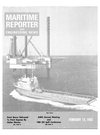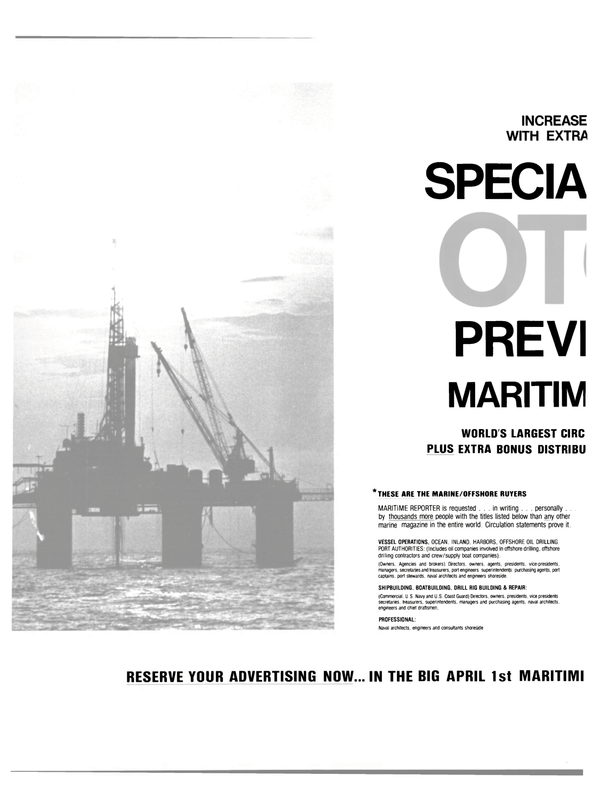
USCG Uses Faster, Easier Stud Welding System —Literature Available
A new teak deck, expected to reduce maintenance and improve appearance, was installed recently on the Eagle, the U.S.
Coast Guard training ship.
Three-inch-thick teak planks were secured to the steel deck by Nelson stud welding — a semi-automatic arc welding process used for fastening applications throughout the industry.
More than 14,000 threaded Nelson studs, V, inch in diameter and l1i> inches long, were welded to the Eagle with portable guns, controlled electronically. The planks, with holes pre-drilled and counterbored aboard ship, served as templates for stud locations. Watertight deck nuts were then run down on the studs. Inorganic zinc primet was applied around the studs and studs and nuts were finally covered by an epoxy sealer and wooden plugs.
Before the recent renovation on the Eagle, studs were welded by hand at the USCG yard at Curtis Bay, Baltimore, Md., whenever wood decks were replaced on icebreakers and other ships. For work on the Eagle, the Coast Guard purchased a TR- 2400 stud-welding system, along with studs and accessories, from the Nelson Stud Welding Division of TRW Inc., Lorain, Ohio.
"Stud welding is many times faster and easier than hand welding," says Lt. Comdr.
Joseph Kucinski, who was in charge of work on the Eagle. "For maximum productivity, we purchased a TR-2400 system which is powerful enough to operate two stud welding guns at the same time." For full, free literature on the Nelson Stud Welding system, Write 71 on Reader Service Card
Read USCG Uses Faster, Easier Stud Welding System —Literature Available in Pdf, Flash or Html5 edition of February 15, 1983 Maritime Reporter
Other stories from February 15, 1983 issue
Content
- Raytheon Service Awarded $1-Million Navy Electronics Contract For Conversions page: 4
- USCG Uses Faster, Easier Stud Welding System —Literature Available page: 8
- National Marine Opens Dock-Side Diesel Shop In Harvey, Louisiana —Literature Offered page: 8
- Burrard Yarrows Announces Two Senior Appointments page: 8
- Raytheon Company Forms New Office Of Corporate Marketing page: 8
- Successful Trials Held For Heavy Lift Vessel Sibig Venture page: 10
- Raytheon Holds SatCom Engineering Seminar page: 10
- NABRICO Names Holland Tidewater Area Distributor page: 10
- INTERNATIONAL OIL SPILL CONFERENCE page: 14
- Irvine Named General Manager And Chief Surveyor For AMT Panama page: 23
- Ocean Carriers Seeks MarAd Approval For T-5 Tankers Charter To MSC page: 24
- TeleSystems Concludes Distribution Agreement With Grove Of Canada page: 24
- Eastern Marine Delivers Trinity River To Transportation Resources page: 25
- COAL EXPORTS page: 26
- Navy Secretary Says '83 Budget Permits Fleet To Reach 600 Ships page: 27
- Halter Marine Delivers First Of Four 191-Foot Supply Boats To Point Express page: 30
- Navy Solicits Qualified Sources To Overhaul Ships Machinery page: 30
- First Of Five Tankers For USSR Christened At Rauma-Repola Yard page: 32
- LR#s Offshore Register Shows Increase Of Over 100 Units In Mobile Drilling Rigs page: 32
- $4.5 Million In Cost Increases Approved By MarAd For Two Ro/Ro's page: 32
- AWO 40 YEARS OF PROGRESS page: 34
- Navy Exercises Final Options In $1.7 Billion T-AKX Program page: 37
- Leevac Shipyards Delivers 165-Foot Supply Vessel To Offshore Express page: 38
- Bay Shipbuilding Completes Repairs To USCG Cutter Mackinaw Ahead Of Schedule page: 39
- Newport News Announces Five Executive Appointments page: 40
- USS Ticonderoga, First Of New Class Of Cruisers, Joins The Fleet page: 41
- Amos Baki Appointed Vice President At Rosenblatt & Son page: 42
- Frydenbo Names Triconn Licensee In U.S. For Rotary Steering Gear page: 42
- Report Available On Computer Data Transfer Via Maritime Satellite page: 43
- Hitachi Zosen Shipyard Delivers 53,538-Dwt Car/Bulk Carrier page: 49
- •Blount Delivers Cruise Vessel For Chesapeake Bay Service page: 49
- Air Hoists Help Speed Propeller Repair At Todd's Seattle Yard page: 49
- Asia Pacific Launches Supply Vessel For National Marine page: 54
- Malcolm Dick Elected President Of Gibbs & Cox Naval Architectural Firm page: 55
- Free Interface Offered With Texas Instruments' SatNav —Literature Available page: 55
- New Managing Director Appointed At Neorion page: 55
- General Dynamics Elects Fritz G. Tovar To New Vice Presidential Posts page: 55
- Free 24-Page Color Brochure Describes Deutz B/AM 816 Diesels page: 55
- New Model Pilot Ladder Has Easily Replaced Steps —Literature Available page: 55


